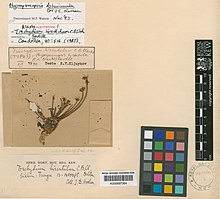Kleptotype
In taxonomy, a kleptotype is an unofficial term referring to a stolen, unrightfully displaced type specimen or part of a type specimen.[1][2][3][4]

Etymology
The term is composed of klepto-, from the Ancient Greek κλέπτω (kléptō) meaning "to steal",[5][6] and -type referring to type specimens. It translates to "stolen type".[citation needed]
History
During the Second World War biological collections, like the herbarium in Berlin have been destroyed. This led to the loss of type specimens.[7][8] In some cases only kleptotypes have survived the destruction, as the type material had been removed from their original collections.[8] For instance, the type of Taxus celebica was thought to be destroyed during the Second World War, but a kleptotype has survived the war in Stockholm.[9]
Kleptotypes have been taken by researchers, who subsequently added their unauthorised type duplicates to their own collections.[10]
Consequences
Taking kleptotypes has been criticised as destructive, wasteful, and unethical. The displacement of type material complicates the work of taxonomists, as species identities may become ambiguous due to the lacking type material.[10] It can cause problems, as researchers have to search in multiple collections to get a complete perspective on the displaced material.[11][10] To combat this issue it has been proposed to weigh specimens before loaning types, and to identify loss of material through comparing the types weight upon return.[12] Also, in some herbaria, such as the herbarium Kew, specimens are glued to the herbarium sheets to hinder the removal of plant material. However, this also makes it difficult to handle the specimens.[13]
Rules concerning type specimens
The International Code of Nomenclature for algae, fungi, and plants (ICN) does not explicitly prohibit the removal of material from type specimens, however it strongly recommends to conserve the type specimens properly.[2] It is paramount that types remain intact, as they are an irreplaceable resource[11] and point of reference.
References
- ^ Baker, N. T., & Timm, R. M. (1976). "Modern type concepts in entomology." Journal of the New York Entomological Society, 201-205.
- ^ a b Glime, J. M., & Wagner, D. H. (2013). "Herbarium methods and exchanges."
- ^ Kleptotype. (n.d.). Academic Dictionaries and Encyclopedias. Retrieved November 21, 2022, from https://en_ichthyology.en-academic.com/9763/kleptotype
- ^ "Terms Used in Bionomenclature: The Naming of Organisms and Plant Communities : Including Terms Used in Botanical, Cultivated Plant, Phylogenetic, Phytosociological, Prokaryote (bacteriological), Virus, and Zoological Nomenclature." (2010). United Kingdom: Global Biodiversity Information Facility.
- ^ "Garden Journal. (1961). United States: New York Botanical Garden." p. 213
- ^ "植物命名指南." (2000). p. 36 Taiwan: Council of Agriculture, the Executive Yuan.
- ^ Tripp, E. A., & Koenemann, D. M. (2015). Nomenclatural Synopsis of Sanchezia (Acanthaceae), Fifty Years Since Last Treated. Novon, 24(2), 213–221. JSTOR 44166526
- ^ a b Luteyn, J. L. (2019). TYPIFICATION IN AND CONTRIBUTIONS TO A REVISION OF PSAMMISIA (ERICACEAE: VACCINIEAE). Journal of the Botanical Research Institute of Texas, 13(2), 397–449. JSTOR 26844040
- ^ Hao, D. (2021). "Taxaceae and Cephalotaxaceae: Biodiversity, Chemodiversity, and Pharmacotherapy." p. 14. United Kingdom: Elsevier Science.
- ^ a b c Katagiri, T., & Majumdar, S. (2020). (028) "Recommendation for prohibiting unauthorized division of a type specimen." Taxon, 69(6), 1381-1381. doi:10.1002/tax.12377
- ^ a b Sigler, L., & Hawksworth, D. L. (1987). "International commission on the taxonomy of fungi (ICTF) code of practice for systematic mycologists." Mycopathologia, 99(1), 3-7.
- ^ Berendsohn, W. G., Anagnostopoulos, A., Hagedorn, G., Jakupovic, J., Nimis, P. L., Valdés, B., ... & White, R. J. (1999). "A comprehensive reference model for biological collections and surveys." Taxon, 48(3), 511-562.
- ^ van Steenis-Kruseman, M. J., & Van Steenis, C. G. G. J. (1950). "Malaysian plant collectors and collections being a cyclopaedia of botanical exploration in Malaysia and a guide to the concerned literature up to the year 1950." Flora Malesiana-Series 1, Spermatophyta, 1(1), 2-639.
